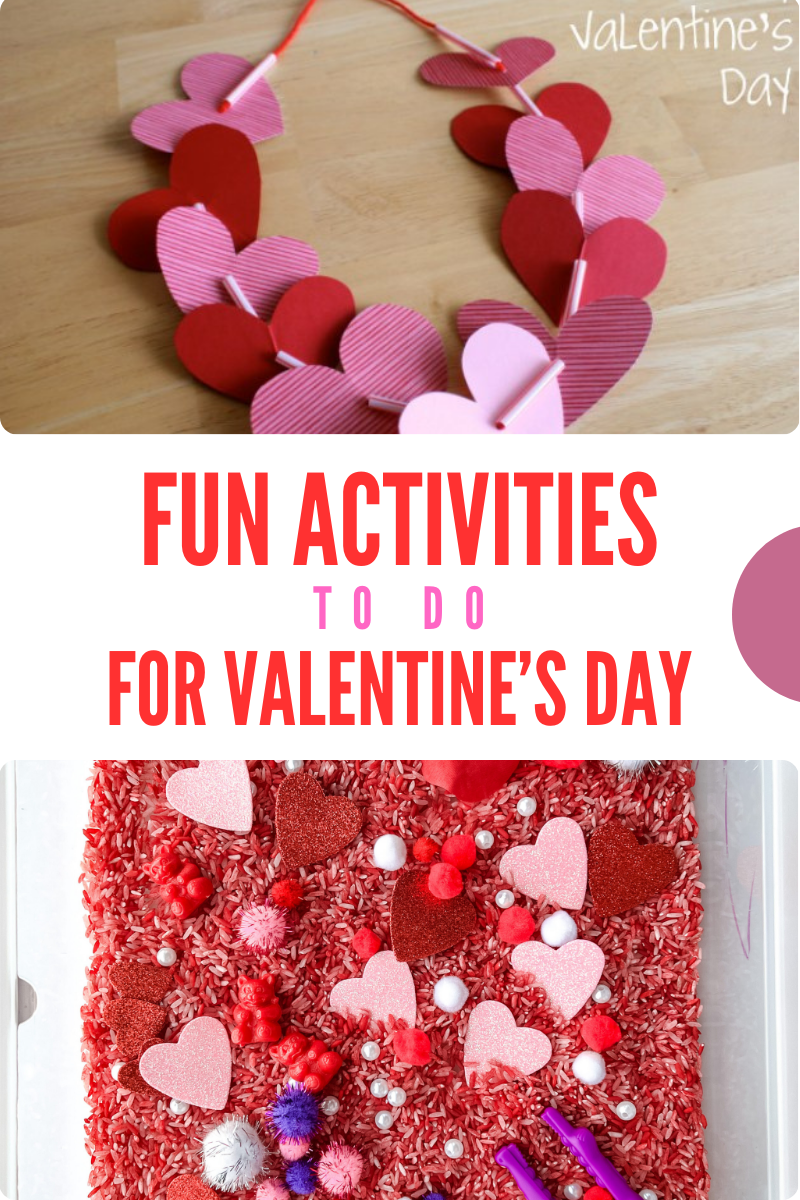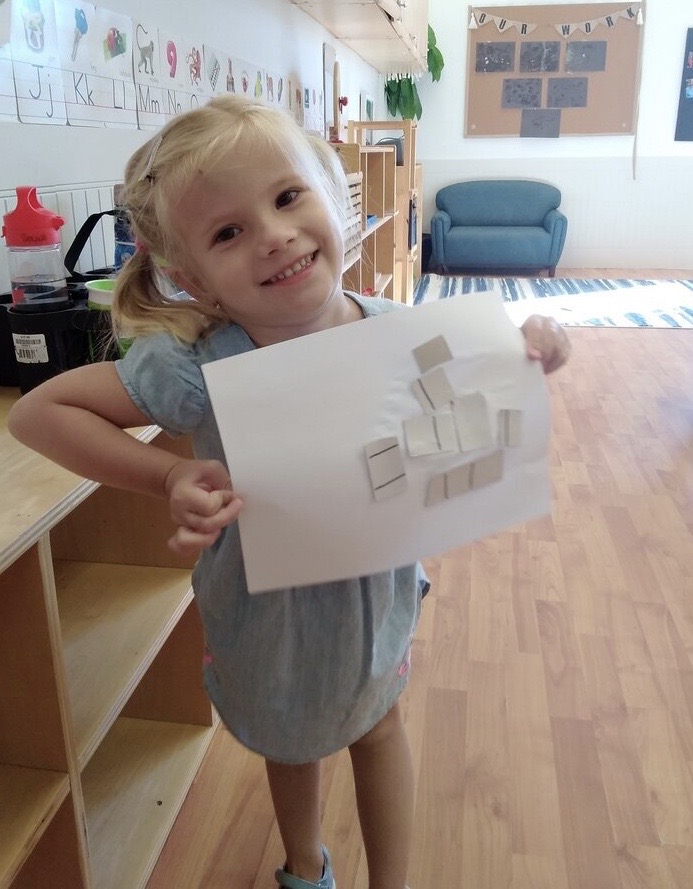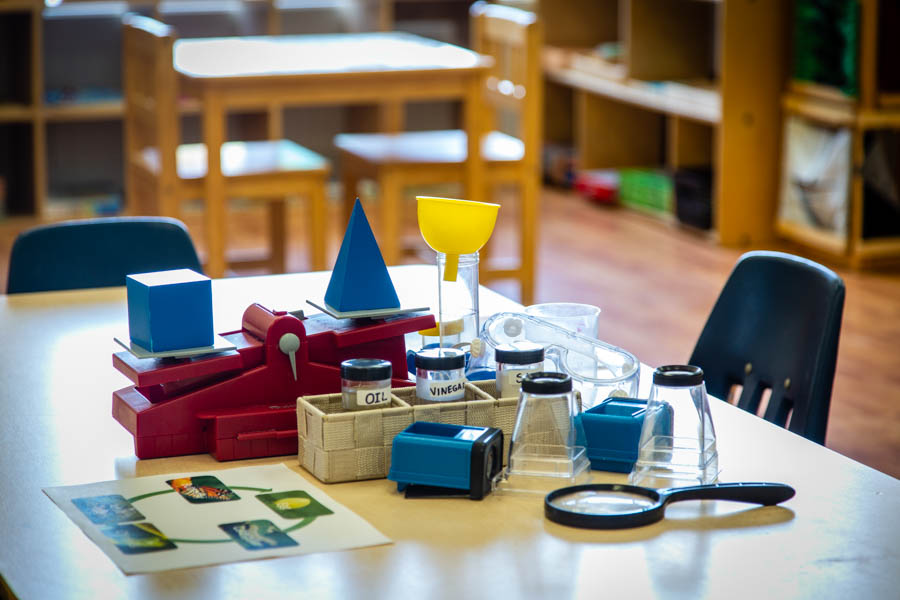7 Valentine’s Day-Themed Activities for Preschoolers
Love, Learning, and Little Hands: 7 Valentine’s Day-Themed Activities for Preschoolers
February is the perfect time to blend love and learning with engaging, hands-on activities. Learning through play fosters curiosity, creativity, and confidence in young children. This blog will explore STEAM, fine motor, sensory, literacy, and math activities—all with a Valentine’s Day twist!
STEAM Exploration: Science
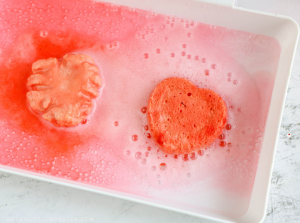
1. Fizzing Heart Science
- Materials: Baking soda, water, vinegar, heart-shaped cookie cutters, food coloring
- Exploration: Mix baking soda with pink/red colored water, shape it into hearts using the cookie cutter. Let it dry and then drop it on a plate of vinegar and watch it fizz!
- Learning: Introduces simple chemical reactions and cause-and-effect.
2. Floating Hearts – A Surface Tension Experiment
- Materials: Dry-erase markers, white ceramic plate, water, straw or spoon
- Exploration: Draw small hearts on the plate with a dry-erase marker. Slowly pour a small amount of water onto the plate. Watch as the hearts lift off and float! Use a straw or spoon to gently move them around.
- Learning: Introduces kids to surface tension and water resistance. Encourages observation and prediction in a fun, hands-on way.
Fine Motor Fun: Strengthening Little Hands
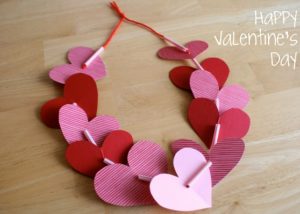
3. Heart Threading Garland
- Materials: Yarn, hole-punched paper hearts, plastic needle
- Exploration: Encourage kids to thread paper hearts onto yarn to create a festive garland.
- Learning: Develops hand-eye coordination and fine motor control.
4. Valentine’s Day Playdough Invitation
- Materials: Pink/red playdough, heart-shaped cookie cutters, buttons, beads
- Exploration: Let kids press, roll, and shape the dough into fun Valentine’s-themed designs.
- Learning: Supports creativity and strengthens finger muscles for pre-writing skills.
Sensory Play: Engaging the Senses
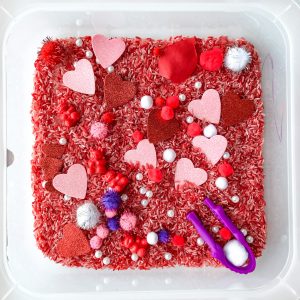
5. Valentine’s Sensory Bin
- Materials: Dyed rice (red/pink) or pink/red shredded paper, heart-shaped objects, foam hearts, scoops, small containers
- Exploration: Let kids scoop, pour, and sort items in the bin.
- Learning: Encourages sensory exploration, sorting, and fine motor skills.
Literacy and Math Exploration
6. Heart Letter-Matching Game
- Materials: Paper or foam hearts with uppercase and lowercase letters
- Exploration: Cut hearts in half with one side having the uppercase letter and the other half with the matching lowercase letter. Kids match uppercase and lowercase letters to complete the heart.
- Learning: Reinforces letter recognition and early literacy.
7. Counting Hearts Game
- Materials: Paper hearts with numbers, small manipulatives (pom-poms, beads)
- Exploration: Children place the correct number of manipulatives on each numbered heart.
- Learning: Develops number sense and one-to-one correspondence.
Incorporating Valentine’s Day into learning offers a great opportunity to foster inquiry, discovery, and exploration at home. These activities make learning fun and meaningful while strengthening early childhood skills. This is a great way to embrace playful learning and enjoy quality time with your little ones.
Unlocking the Wonders of STEAM: Embracing the Power of Math
Unlocking the Wonders of STEAM: Embracing the Power of Math
by Susie Beghin, RECE, Founder of Alpha’s Discovery Kids
At Alpha’s Discovery Kids, we are passionate about providing a nurturing and enriching learning environment where children can thrive.
As advocates of STEAM education, we wholeheartedly embrace the power of Science, Technology, Engineering, Arts, and Math in shaping well-rounded individuals. Our commitment to excellence lies in infusing STEAM concepts throughout our curriculum, empowering young minds with essential skills and fostering a love for learning that lasts a lifetime.
And that’s why we created our unique and comprehensive approach to education, centered around the “The Four Pillars of Learning.” These pillars serve as the foundation of our curriculum, ensuring that every child’s physical, cognitive, social, emotional, and spiritual well-being is nurtured and supported.
The 4 Pillars of Learning consist of Language & Literacy, STEAM (Science, Technology, Engineering, Arts, and Math), Physical Activity & Nutrition, and Mindful Awareness. Each pillar is carefully designed to complement and reinforce one another, creating a holistic learning experience that fosters creativity, critical thinking, and a growth mindset in our young learners.
By embracing these four pillars, we aim to provide a well-rounded education that prepares children not only for academic success but also for personal growth and success in all aspects.
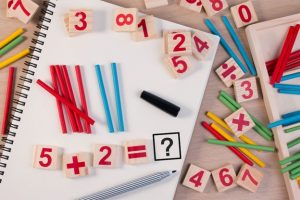
When it comes to Math, it is more than just numbers and equations. Math is a fundamental tool for understanding the world around us. From counting and measuring to problem-solving and critical thinking, math plays an integral role in shaping a child’s cognitive abilities and analytical skills.
Math is an important part of a child’s development from ages 1 to 5 years. During this time, children explore patterns, shapes, sizes, and counting and encounter math concepts in their everyday activities, from counting cars on the road to the number of plates on the table.
However, math can be daunting for both kids and parents. That’s why we believe in teaching math in a visual and hands-on way. For example, when we say 1 plus 1 equals 2, it’s easier to understand when we can see and touch objects to represent those numbers. We want children to experience math in a concrete way, so they truly grasp its concepts.
Math is all around us, and it’s essential to make it approachable and enjoyable for everyone. Some important math skills that we focus on here at Alpha’s Discover Kids include:
Numeracy skills – Skills like counting are among the first things children learn. Many children learn to count from 1 to 10 by age three. We encourage counting everyday objects in a hands-on way to help them grasp the concept. Once children start to understand the concept of counting, you can introduce written numbers so they learn to associate the written form with the concept.
Problem-solving – Another essential math skill is problem-solving, although this can be a tricky concept for many kids. We support children in their problem-solving process without doing it for them. By using number concepts and skills, we help them develop confidence in their own ability to think things through.
Measurement – Measurement is an exciting aspect of math. Children can explore time, weight, distance, length, height, and width in various activities.
Classification – Classification is a fun game where children sort and classify objects based on different characteristics like shape, size, or colour.
To incorporate math into everyday activities, we sort various items into baskets, provide objects to count while filling and emptying containers, and make number figures from play dough. These activities make math a part of their daily fun, helping children build essential math skills while having a great time.
We aim to instill a love for Math by making it accessible, enjoyable, and applicable to the real world. We foster a growth mindset, where children embrace challenges, ask questions, and take risks in their mathematical explorations.
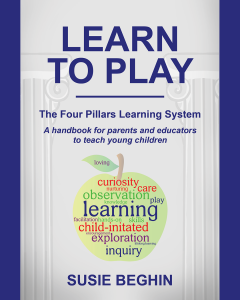
For more information about how to use the Four Pillars of Learning system, check out Susie’s book, Learn To Play: The Four Pillars Learning System on Amazon.
For more information about Alpha’s Discovery Kids, or to book a tour, please contact us at https://www.alphasdiscoveryclub.com/contact/ or call us at 905-823-8257.
Unlocking Creativity and Expression: The Essential Role of Art in STEAM Education
Unlocking Creativity and Expression: The Essential Role of Art in STEAM Education
by Susie Beghin, RECE, Founder of Alpha’s Discovery Kids
“Art is about letting go” – Susie Beghin
At Alpha’s Discovery Kids, our mission is to create a nurturing and safe space where every child feels at home. We understand the significance of holistic education, especially during the formative years of early childhood. As young minds develop rapidly, we recognize the importance of providing the best learning environment to support their growth and development.
Childhood is a time of exploration, curiosity, and boundless creativity. That’s why we believe in child-initiated and teacher-supported learning experiences that encourage children to be active participants in their education. Our commitment to fostering a love of learning led us to develop the Four Pillars of Learning: Language & Literacy, STEAM (Science, Technology, Engineering, Art, and Math), Physical Activity & Nutrition, and Mindful Awareness.
While traditional STEM education focuses on Science, Technology, Engineering, and Math, we believe that incorporating the Arts (A) into the equation is vital. The Arts, in the context of STEAM, play a transformative role in nurturing creativity, critical thinking, and problem-solving skills in children.
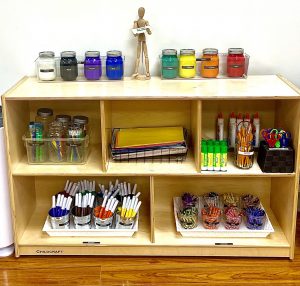
Art is often misunderstood or underappreciated as a vital component of learning. Some may view art as an extra-curricular activity or mere creative play, not realizing its significant contributions to a child’s development. However, we firmly believe that art is not just about drawing or painting; it is about the creative process and fostering imagination.
For instance, art and creativity are fundamental to engineering. Engineers need to think outside the box, innovate, and find solutions to complex problems. Art allows children to think creatively, develop original ideas, and view challenges from various perspectives, which are essential skills for future engineers.
Art is also a process-oriented activity rather than a product-oriented one. It encourages children to explore their imagination, experiment with different materials, and express themselves freely. The act of creating art builds fine motor skills as children learn to hold crayons and paintbrushes. Through art, they learn to communicate their thoughts and emotions, developing their language and self-expression abilities.
At Alpha’s Discovery Kids, we emphasize the importance of providing opportunities for children to engage in art freely. There should be no pressure to create a specific end product; instead, we focus on allowing children to explore and experiment with materials independently. Art is about letting go, embracing creativity, and embracing the joy of the process itself.
There are countless art ideas that children can explore, from painting and drawing to molding and collage-making. We provide various materials, such as markers, child-safe scissors, paint, glue, feathers, and pompoms, to ignite children’s imagination and creativity. By providing open-ended materials, we empower children to choose how they want to participate and let their creativity flow.
We also integrate art with other STEAM components to create a multidimensional learning experience. For instance, while making an animal out of clay (art), we can build the animal’s home (engineering), learn about its characteristics (science), find pictures of the animal on the computer (technology), and measure its size (math). This interdisciplinary approach enhances children’s understanding and application of knowledge. You can find out more about how to incorporate art into STEAM in Susie’s book, Learn To Play.
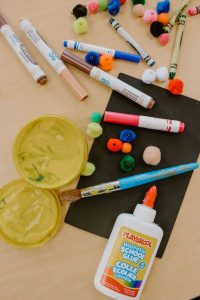
Art is not just crafts; it goes beyond following instructions and specific outcomes. We emphasize the process of making art, encouraging children to explore different materials and techniques. For instance, instead of merely painting on paper, we might encourage children to paint with a straw on a cardboard box, adding multiple dimensions to the experience.
Incorporating the Arts into STEAM education allows us to nurture creativity, self-expression, and problem-solving skills in children. It sets the stage for future innovation and exploration, fostering a love of learning that lasts a lifetime. At Alpha’s Discovery Kids, we celebrate art as a vital aspect of our holistic approach to education, empowering children to become confident, creative, and compassionate individuals.
For more information on our Four Pillars of Learning, or to book a tour, please contact us at https://www.alphasdiscoveryclub.com/contact/ or call us at 905-823-8257.
Engineering in the Early Years
Four Pillars Of Learning – Pillar #2 – STEAM (Engineering edition)
by Susie Beghin, RECE, Founder of Alpha’s Discovery Kids
My mission has always been to provide children with the best possible start in life and help them develop the critical skills they need to thrive.
When I began writing my book, ‘Learn To Play,’ my primary goal was to use the experiences and knowledge I have gained as an ECE educator and mother. It was also a way for me to document our daycare curriculum and make it accessible to parents everywhere!
The Four Pillars of Learning is a comprehensive program that addresses a child’s physical, cognitive, social, emotional, and spiritual well-being. It comprises Language & Literacy, STEAM (Science, Technology, Engineering, Art, and Math), Physical Activity & Nutrition, and Mindful Awareness.
At Alpha’s Discovery Kids, these pillars are prominently displayed in every classroom across our three locations, and our goal is to ensure children have access to a well-rounded education while learning in a meaningful (and fun) way.
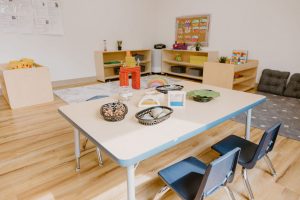
Pillar 2 – STEAM – E is for Engineering
One of the pivotal parts of STEAM is engineering, but when people hear the term ‘engineering,’ they often think it’s something that young children cannot do. However, I use the term intentionally because engineering is precisely what these children do. “Engineering is the process by which young children discover how things in their world are built, and how they work”.
One of the ways we teach engineering in our classrooms is through dedicated and specific areas for construction and building activities. In my last blog, we detailed the integral part that loose parts play in children using their creativity and imagination while learning.
And alongside loose parts, we incorporate materials such as blocks, which hold a special place in my heart. The reason I love blocks is that they are open-ended and allow children to create anything they desire, promoting imagination and creativity. In engineering in our classrooms, we have and use blocks of all sizes, which encourage stacking, sorting, connecting, and disconnecting.
When children engage in engineering activities, they often gravitate towards building tall towers. There is a sense of accomplishment in constructing something tall, even if it only lasts for a few seconds before being knocked down. Both the act of building and knocking down are significant learning experiences, as it allows children to explore concepts of balance, size, and structure as they figure out how to make their towers taller and more stable.
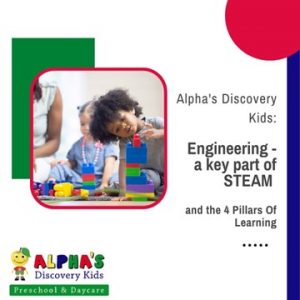
In engineering, we also shift our focus from the end product to the process itself. Instead of dictating what children should create, we provide them with materials and let them decide how to use them. The learning lies not in making a specific object but in gaining insights into size, balance, and cooperation. Engineering becomes a cooperative activity where children work together, negotiate, and problem-solve as they construct and interact with their creations.
The construction area of our classrooms also serves as a hub for social skill development. Children learn to collaborate with their peers, navigate conflicts, and share ideas. They face situations where they need to communicate their preferences and make decisions collectively. It’s an environment that fosters cooperation and encourages children to develop essential social and emotional skills.
The construction area is often our classrooms’ most popular and well-utilized space. Children are drawn to the joy of building and creating. It is a place where their imaginations come alive, they have the freedom to experiment, and they can engage in hands-on learning experiences. As a result, we allocate significant space to this area, recognizing its importance in promoting exploration, creativity, and problem-solving.
Through our focus on engineering, we strive to instill a sense of wonder and curiosity in children. We want them to understand that the process of building and creating is just as valuable as the end result. By embracing engineering in early childhood education, we provide children with opportunities to develop critical thinking skills, expand their imaginations, and foster cooperative relationships.
At Alpha’s Discovery Kids, we are committed to cultivating a love for learning and empowering children to become lifelong learners. Our Four Pillars of Learning, including the exploration of engineering through STEAM, form the foundation of our curriculum. Through these pillars, we create an environment where children can grow, explore, and discover their talents.
For more information on our 4 Pillars of Learning, or to book a tour, please contact us at https://www.alphasdiscoveryclub.com/contact/ or call us at 905-823-8257.
4 Pillars Of Learning – Pillar #2 – STEAM (Science)
4 Pillars Of Learning – Pillar #2 – STEAM (Science)
by Susie Beghin, RECE, Founder of Alpha’s Discovery Kids
At Alpha’s Discovery Kids, we aim to create a nurturing, safe space where every child feels they are in their home away from home.
And we know that the first six years of a child’s life are the most formative. These are the years when young brains develop rapidly, and children are like sponges, soaking up information and modelling behaviours from those around them.
That’s why providing the best learning environment possible is at the core of everything we do. We are committed to showing children how to develop the critical skills they need to succeed in life.
With each child’s unique strengths taken into account, we believe in child-initiated and teacher-supported learning experiences that foster their naturally inquisitive nature and cater to their individual needs.
We do this by focusing on our 4 Pillars of Learning: Language & Literacy, STEAM (Science, Technology, Engineering, Art and Math), Physical Activity & Nutrition and Mindful Awareness.
And as you walk through each of our Alpha’s Discovery Kids locations, you’ll experience our award-winning 4 Pillars Of Learning system echoed in each classroom.
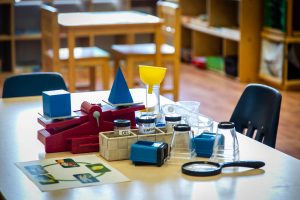
SCIENCE (The first component of STEAM)
We infuse learning in everything we do and believe that the strength of our pillars is in combining learnings from multiple pillars.
Science activities are a fan favourite at Alpha’s Discovery Kids, as it often involves many things to do with nature.
Some of the fun ways we introduce and teach science include:
- Nature walks – a great way of combining physical activity, mindfulness, language and science, nature walks are a fantastic way of sparking children’s natural curiosity. With so many things in nature to see, children can experience a multi-sensory world of wonderment on every trip outside.
- Bringing nature inside – with so many aspects of nature for children to learn, we love bringing nature inside. This can include sensory bins filled with soil, mud painting and exploring the various properties of soil (from dry to wet). Kids also enjoy planting seeds inside pots which stay in the classroom until they are ready to be transplanted outside in the spring.
- Look beyond chemistry – a lot of people associate science with chemistry. And we absolutely enjoy doing some fun chemistry experiments in our classrooms. But there are so many different aspects of science to explore, including astronomy, biology and physics. We dabble in every area of science so that our children can explore the various disciplines of science.
At Alpha’s Discovery Kids, we find that children, in general, are budding explorers, and science is all about exploration and discovery. So we encourage each of our children to understand that as they explore something new in their world, they’re actually little scientists!
As we teach science in our classrooms, it’s done in an age-appropriate manner. For our toddlers, we teach science through several activities, focusing on sensory-oriented activities. We find that toddlers love exploring sensory bins, experimenting with water, how various items float, how sand flows through different sieves and exploring a wide variety of natural materials, including pine cones, soil, leaves, etc.
As we progress through the older ages, kids explore science by creating their own solar system, making their own planets and learning where each is located. We also begin to explore sources of energy, the differences between living and nonliving things, the different types of animals and plants, and their characteristics.
By making science fun, we can tap into a child’s natural desire to learn.
For more information on our 4 Pillars of Learning, or to book a tour, please contact us at https://www.alphasdiscoveryclub.com/contact/ or call us at 905-823-8257.
Sr. Preschool/Kindergarten Program – Ages 3.5-5 years
SENIOR PRESCHOOL/KINDERGARTEN PROGRAM – AGES 3.5-5 years
Alpha’s Discovery Kids Sr. Preschool/Kindergarten program offers advanced academic opportunities which promote learning readiness for primary school preparation. Our Kindergarten program is based on our unique curriculum called the Four Pillars of Learning, which incorporates a holistic approach to learning using the four pillars. As our students become more independent, we can devote more time to an increased level of academics. We approach this as an opportunity to build upon each child’s abilities and strengths to reach full potential in all areas. Our holistic approach is consistently based on providing a sense of belonging, engagement, security, and nurturing. We provide an environment that is stimulating, fosters curiosity and encourages inquiry-based learning. We provide child-led and teacher supported learning experiences to encourage the mental, physical and spiritual growth of our students. We strive to achieve the utmost quality of care while working along side families as a partnership. The relationship we strive to create allows us to fully to embrace, encourage and maximize learning and support well being in each individual child. This program is designed to build skills, confidence and empower the “Alpha” in each one of our students before moving into the primary grades.
Four pillars planning time –The children will come to the table to gather where they will have their printing cards ready for them. During this gathering time the educator will present any new options that are available in the room for the morning work period. The children will have an opportunity to choose which activities they would like to work on, or what materials they would like to explore. The educators will recognize each choice and what area of the room the child is interested in. The educators will also encourage inquiry to further engage the children’s minds, promote exploration as well as develop further awareness and mindfulness as they carry out their learning each day.
Pillar 1 – Language and Literacy
Language and Literacy is our first pillar of learning as we focus on building communication skills as the foundation of all other learning.
Progressive printing cards –This fine motor/literacy activity will allow the children to progressively improve upon their printing skills each day. This process will be gradual and based on each child’s ability level. This process may begin with hand over hand, tracing and eventually as their abilities progress, the children will soon be able to print words independently (starting with their own names). This process will prepare children for name recognition and lead to phonological awareness and the ability to read and write.
Phonics – We will be using an inductive approach to motivate the children to learning letter sounds. By using the multi-sensory components of the Jolly Phonics program, we can make learning synthetic phonics fun. We do this by incorporating songs and games into their activities.
Pillar 2 – STEAM Learning (Science, Technology, Engineering, Art and Math)
Work Time – Educators will plan activities to explore STEAM learning each day. During Work Time, children will choose areas of the classroom to explore Science, Technology, Engineering, Art, Math, Language, Literacy, Nature, Fine motor, Dramatic, Music and Movement, Sensory Activities. Children will explore materials in the classroom in each of these areas in a meaningful and purposeful way. The Work Time period takes place two times per day, in the morning and afternoon.
Collaborative Reflection Time and Showcase of work – During work time, the children will be able to put their name card on any work they would like to save and share during gathering time. If it is not possible to save the work, a photo will be taken so that it can be shared with the group. During collaborative reflection time, the children will be given the opportunity to share their work or photo (both independent and collaborative). This process will enhance the children’s experience during work time, allowing a focus on uninterrupted work schedules and helping to develop their skills in whatever domain they are working (fine motor, spatial relationships, creativity, problem solving, language and literacy etc.). Additionally, allowing children time to present their work within a group environment, with the active help of their teacher, will support children’s socio-emotional development, self-confidence, descriptive language, stimulating peer interactions and co-operative skills. This will inevitability build upon each child’s natural curiosities individually and as a group.
Collaborative Lesson – In the afternoon, there will be a teacher-led presentation of material and activity demonstration to build further inquiry in Math, Science, Language, Literacy and French. This will be an opportunity for each child to gather and learn through collaboration with the educator and peers. This gives the educator an opportunity to plant seeds to create new interest and inquiry-based learning or build upon existing interests within the classroom. Following this lesson, the children will have the opportunity to work independently in addition to working in collaboration with peers.
Pillar 3 – Physical Activity and Nutrition
Outdoor Time – Developing a lifelong healthy lifestyle starts in the early years. Our third pillar of learning is an important component of our program to not only provide opportunities for physical activity and healthy meals but also to instill the importance of the overall health benefits of both. We offer two outdoor time periods in the day (morning and afternoon) for physical activities as well as indoor physical activities to promote physical fitness and well being. We strongly believe that fresh air and engaging in nature along with healthy eating are valuable daily practices at all times of the year.
Lunch/Snack Time – We reinforce a healthy lifestyle by modelling healthy eating habits and participating in family-style dining with the children. We discuss portions, nutritional facts and provide a variety of food choices to help children develop an understanding of how to take care of the human body.
Daily Routines – Including daily routines where the children practice independent tasks such as pouring, scraping their dishes, cleaning up after themselves and using manners, we build on other valuable areas of development such as physical fine motor skills, accountability, confidence and empowerment.
Pillar 4 – Mindful Awareness
Mindfulness is incorporated in all parts of the daily routine and curriculum. Educators reinforce this concept through daily conversations and interactions between educators and children. We discuss choices and acknowledge feelings to create awareness within and promote social-emotional health and self-regulation skills. Educators provide tools and strategies to help children to learn how to manage stress, anxiety and interact with peers in a positive manner.
Mindful Yoga – During our mindful yoga practice, we reinforce this by honouring our physical health and promoting self-regulation. This part of the daily routine is intended to provide the children an opportunity to go within and experience a sense of calm each day. This practice encourages the children to shift gears and allow for quiet self-reflection within their minds and bodies. This practice will be carried out in several different methods and the children will be encouraged to embrace this as a tool to manage stress, anxiety, increase self-control, and sustain attention. Children will develop the ability to focus, visualize, improve balance and develop an acceptance of self and others.
To learn more and register for the program: click here
Sr Preschool-Kindergarten Program Schedule 2020_ Fall
STEAM – How to Foster a Love for Science Discovery in Young Children
At Alpha’s Discovery Kids Preschool and Daycare, we understand the importance of educating children in all areas to help them to grow and develop. Science is one of the key programs that we focus on in our Four Pillars of Learning curriculum. It is the first letter in our STEAM program. Science can be a hard area for some of us to wrap our heads around, especially as adults. We think of volcanos and osmosis when we think of science, but if you look at the activities your child does in their day, science is everywhere.
By introducing science to children at a young age, we begin to foster their interest in the subject and their success in that subject at school. It helps them to problem solve and better understand their world around them. Science allows children to make predictions, complete observations and determine an outcome. Science easily links with many other parts of our program such as math and art. For example, we discuss the types of animals in the arctic and the temperature (math), and have them create puppets from paper bags (art).
Science is also a great way to calm children. If negative behaviours are happening at home or at school try using art and science as a way to alleviate some of those issues. Children generally love exploring with science, they love the mess, and the use of imagination. Simply mixing colours is a great way to show children science. Ask them what they would get if they mixed red and blue, blue and yellow or red and yellow. Have them try mixing their own colours to see how many different colours can be made.
Children want to be involved. Science can be simple at home as well. You can grow a garden or flowers. Allow them to help put in the soil, to water the plants. Make a graph of how tall it is getting. Show them how you can cook with what you grow. Cooking can involve both math and science by measuring and mixing ingredients to make something new. All these things are simple and will help your child to be excited about learning.
Here’s a list of some great simple science experiments that we do with the children in our programs that you can try at home.
1. Lava lamp. Take a water bottle and fill it with the following ingredients.
a. Water
b. Oil
c. Food colouring
2. Colour changing flowers. Put the flowers in a glass with water and food colouring and watch the flowers change colours.
a. White carnations
b. Glasses
c. Water
d. Food colouring
3. Magic milk (one of my favourites). Mix all the ingredients on a tray. Watch what happens.
a. A large flat tray
b. Milk
c. Liquid food colouring
d. Dish soap
e. Cotton swabs
4. Painting on ice cubes.
a. A piece of ice
b. Paint
c. Tray to collect the water as it melts
All of these simple activities can be found online on Pinterest and in Youtube videos. They are simple and easy to do and you may find your child asking to do them over and over again. With any science experiment it is important to ask questions.
1. What do you think will happen? – Make a prediction.
2. What actually happened? – Observe the results.
3. Why/How did it happen? – Make a hypothesis to explain what happened. You may need to do some research with your child to explain why or how it happened.
It is always fascinating to make observations about what your child was able to understand. Then 6 months later do the same activity. You will be amazed at how much more your child is aware of and the questions they ask. Now get out there and have fun.
Visit our curriculum page for more information about how we incorporate science into our four pillars of learning through the STEAM curriculum. We have truly developed an exceptional program that focuses on the child as a whole. We believe that language, literacy, STEAM and mindfulness can provide children a path for continuous growth.

